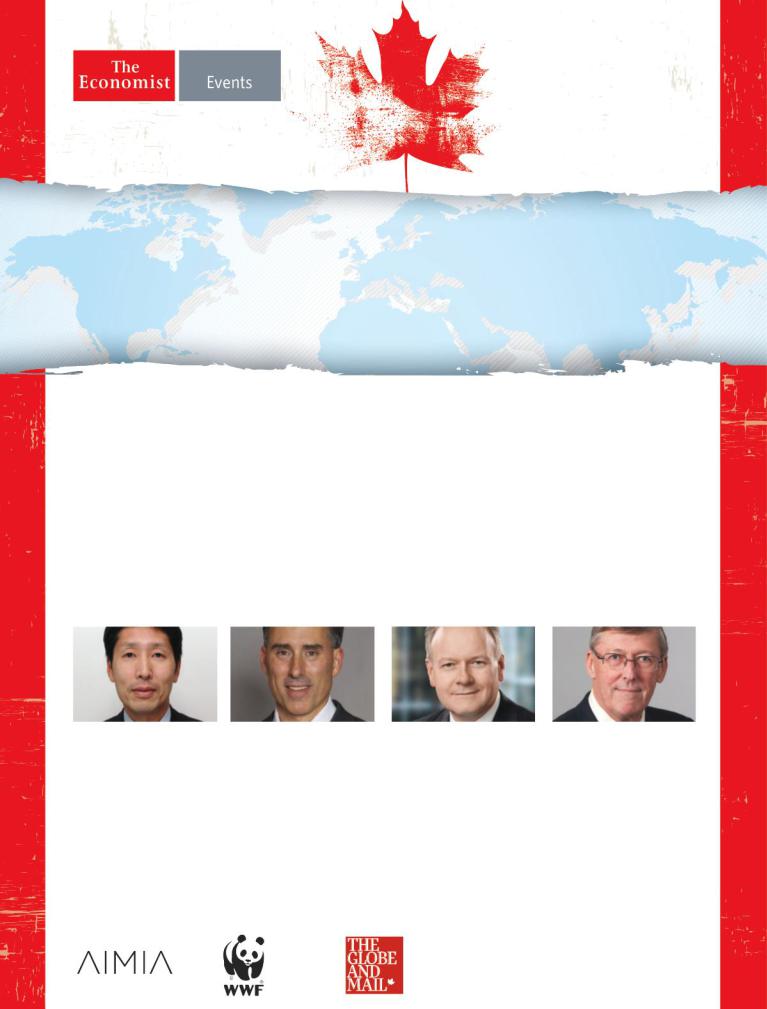
The Economist - NOVEMBER 22ND-28TH 2014
.pdf
The dream:
To share my mom’s cooking with the world.
The reality:
Deliveries. Paying bills. Scheduling staff. Before I start today’s specials.
There’s having your dream, and then there’s dealing with the day-to-day realities to make it happen. That’s called owning your own business. Verizon can help you handle those realities. See why more businesses choose Verizon Wireless than any other wireless carrier.*
Get a $300 account credit for your business
when you trade in your old smartphone and purchase a new 4G LTE smartphone.
$200 Trade-In Account Credit plus additional $100 Bill Incentive
Credit when activating a new 4G LTE smartphone. Trade-in smartphone must be in good working condition. New 2-yr activation req’d.
For the dream and the reality, choose Verizon. 1.800.VZW.4BIZ vzw.com/livethedream #LiveTheDream
*Results based on third-party study. Eligible devices include all 4G Smartphones and 3G iPhone 4s. Bill credit may take up to 2–3 billing cycles to process. Credit will be removed from account if line is suspended or changed to nonqualifying price plan after activation. Offer expires 12/31/2014. Activation/line: Up to $35. IMPORTANT CONSUMER INFORMATION: Corporate Subscribers Only. Subject to Cust or Major Acct Agmt, Calling Plan, & credit approval. Up to $350 early termination fee. Offers & coverage, varying by svc, not available everywhere; see vzw.com. Limited time offer. While supplies last. Restocking fee may apply. ©2014 Verizon Wireless.

62 Business
2 erators are wary of the innovation. They have some legitimate security concerns about the new cards. Most would need to make big changes to their billing systems and other back-o ce functions to adapt to a world in which customers bought their connectivity one gigabyte at a time from a variety of operators, rather than signing a long-term contract. But their biggest fear is that, as they lose control of the customer relationship, margins would surely su er.
It was only late last year that the GSMA, an association of mobile operators, agreed on a common specification forre-program- mable SIMs. Now that Apple is trying out a gadget containing such a card, the operators are watching nervously, to see how consumers react. Of the four biggest wireless carriers in America, only T-Mobile US fullysupportsApple’sexperiment. Verizon decided not to take part. Users of the new iPad can use its re-programmable SIM to sign up for AT&T but will have to install a new card if they want to switch operator later. And those who select Sprint will have to go through a further registration process to activate the service. In Europe only one operator, EE, has agreed to participate so far.
Whatever the outcome, re-programma- ble cards are bound to spread, predicts Philippe Vallée of Gemalto, the world’s biggest maker of SIMs. All sorts of new connected devices are coming along, and operators will have fewer objections to these having the new type of SIM in them. For instance, Gemalto is supplying re-pro- grammable SIMs fora “smart watch” being made by Limmex, a Swiss firm.
The new type of card will gain further momentum if more countries follow the example of the Netherlands, which has just begun to let organisations other than operators issue SIMs, such as utilities and car companies. Germany may be next. If its giant carmakers issued their own SIMs, and rented spare capacity on the operators’ wireless infrastructure, they could together save €2 billion ($2.5 billion) a year through lower prices and more flexible contracts, estimates Rudolf van der Berg of the OECD, a think-tankbased in Paris.
Going soft
The biggest question is whether re-pro- grammable SIMs will find their way into smartphones—and in what form. Apple fans predict that the firm will soon release an iPhone with a pre-installed card that lets them switch providers. Some hope it will eventually take the next logical step, and replace the card with a softSIM, a piece ofsoftware code that does the same job.
Operators would put up sti resistance to puttingre-programmable SIMs, let alone softSIMs, into phones, saysDean Bubley of Disruptive Analysis, a consulting firm. In 2010 Apple was believed to be developing an iPhone that came with such a SIM, but it
|
The Economist November 22nd 2014 |
was reportedly scared o by operators |
card in its current, inflexible form should |
threatening to stop promoting its handsets. |
be careful what they wish for, and not just |
Managing SIMs for phones that handle |
for security reasons. Operators would lose |
voice calls is much more complex than it is |
control of the market, but Apple and other |
for data-only devices. In many countries, |
device-makers might gain it. They would, |
for instance, people have to show an iden- |
if regulators let them, be able to choose |
tity card when signing up. The operators’ |
which operators appeared on the menu |
security worries about softSIMs would be |
when buyers of their phones and tablets |
even greater than those for re-programma- |
were setting them up. The risk would then |
ble cards, says Mr Bubley. |
be that the SIM card’s demise leads to less |
Those hoping for the death of the SIM |
choice, and higher prices for users. 7 |
Companies in Poland
Growing the Polish Apple
WARSAW
Afteryears ofsteadygrowth at home, firms are venturing abroad
NOWY STYL, a Polish company that is Europe’s fourth-largest maker ofo ce furniture, recently bought two small German rivals. The firm’s boss, Adam Krzanowski, was asked by a German friend if he was pleased with his purchase. “I told him that I was not happy with the quality of the workers. His jaw dropped,” says Mr Krzanowski, with a grin. He had to send a team from his factory in Poland to bring his new German workers up to speed on the
latest manufacturing methods.
Polish firmshave grown in size and confidence along with the economy, which after years ofexpansion is twice the size, in real terms, that it was when democracy was restored in 1989. Now, at last, some of its firms are looking beyond the domestic market and going global. InPost is rolling out its automated parcel lockers in nine countries, including Britain (see picture), to grab a share of the rapidly growing business of making deliveries for e-commerce firms. Comarch, a Polish IT firm, has set up two data-processing centres in Germany.
Polish businesses are making more efforts to conquer export markets. Pesa, a trainmaker, won a $1.5 billion contract in 2012 to supply Germany’s Deutsche Bahn with up to 470 new diesel locomotives. “Nobody believed we could sell the Germans such a high-tech product,” says Tomasz Zaboklicki, the firm’s chiefexecutive.
A decade ago the most notable foreign ventures by Polish businesses were the result of a strong prod from the government, usually applied to state-controlled firms with political objectives in mind. The results were dire. In 2004 PKO Bank Polski was encouraged to invest in Ukraine, Poland’s poorer neighbour to the south-east, during its Orange revolution. In Ukraine’s subsequent economic slump, the small bank PKO had bought, Kredobank, suffered a drastic rise in bad loans, eventually forcing PKO to bail it out.
In 2006 PKN Orlen, a state oil refiner, invested $3.7 billion in a Lithuanian plant, with the aim of helping the Baltic states loosen their dependence on Russia. After1

The Economist November 22nd 2014
2years of losses, Orlen has written o most ofits investment.
Now, the Polish firms venturingabroad, even the state-backed ones, are driven by profits rather than politics. In September KGHM, a copper miner in which the state has a 32% stake, began shipments from a Chilean mine jointly owned with Sumitomo of Japan. This follows KGHM’s purchase, in 2012, of Quadra FMX, a Canadian copper and silver miner. In October Grupa Azoty, a fertiliser-maker, announced a plan to make up to ten foreign acquisitions, in Africa and South America aswell asin central Europe, to maintain its position in an industry that is consolidating rapidly.
Although a few Polish firms are gaining a profile outside their home country, they are still the exceptions. Of those local manufacturers that export, many are pro-
ducing materials or parts that end up deep in German cars or consumer products. One problem is that even the largest Polish firms are small by global standards. Anotheris that most have been reluctant to invest in the research and development needed to take on sophisticated foreign rivals.
“I ask myself, ‘Why is there no Polish product which is internationally famous? Why is there no Polish Apple or Google?’,” says Andrzej Kozminski, founder of Kozminski University, the country’s leading business school. He hopes it is simply a matter of time. In another decade, given Poland’s rapid economic growth compared with western Europe’s, its businesses may become large enough that foreign ventures like those of Nowy Styl will become common. If so, more German workers will have to get used to Polish bosses. 7
Canada’s natural-resources companies
Reputation management
OTTAWA
The government promises to keep promoting miners’ and energy firms’ interests abroad ifthey behave themselves
FEW governments have aligned their interests so closely to those of their country’s energy and mining firms as Canada’s Conservative administration. The prime minister, Stephen Harper, has boasted of Canada as an “emerging energy superpower”. Under the banner of “responsible resource development”, his government has done its best to ease the way for minerals firms, at home and abroad, including directing some foreign aid to countries where Canadian firms wanted to drill. Ministers point with pride to the C$174 billion ($169 billion) in export revenues from sales of minerals, oil and gas in 2013 and to the fact that Canada is home to more than half of the world’s publicly listed explora-
tion and mining companies.
But the downside of seeming so cosy with extractive firms is that whenever one of them gets in trouble—an inevitable occurrence with 1,500 firms active in more than 100 countries—the country’s image is tarnished too. So the government has recently begun to reduce that vulnerability by taking a stricter line on corporate social responsibility (CSR) and bribery by Canadian firms operating abroad. Protecting the national brand is “a huge part of it,” says Andrew Bauer ofthe Natural Resource Governance Institute, a group that monitors the industry and lobbies for openness.
Ed Fast, the international trade minister, admitted as much on November14th, as he introduced new rules that require Canadian resources firms involved in disputes with local communities to take part in a
resolution process. If any firms refuse, the government will withdraw its economic diplomacy on their behalf.
In Mr Fast’s eyes, Canada’s brand shines like a freshly minted ingot, and simply needs to be preserved rather than restored. Campaigners beg to di er. They note a slew of protests against Canadian firms’ projects, from Romania (pictured), where environmentalists are objecting to plans for an opencast gold mine, to Guatemala, where guards at a nickel mine have been accused ofgang rape.
The government is also promising to
...but not in Canadian miners
Business 63
strengthen the mandate of its o cial “CSR counsellor”, whose job is to advise resources firms and mediate in their disputes. The post has been vacant for a year, and the previous incumbent made little progress because the companies were not obliged to co-operate. The move did not go far enough for some campaigners, who had wanted the counsellor to be made independent ofgovernment.
Still, they had better luck with a new law introduced last month, to curb bribery by mining and energy firms by demanding more transparency from them. The law, which still must be fleshed out in detailed regulations, requires them to disclose all payments made to domestic and foreign governments. It brings Canada broadly into line with British legislation and with rules being contemplated by the US Securities and Exchange Commission. It helped that the law was backed by an unusual coalition of non-government organisations and mining companies themselves. The legislation “is pretty faithful to our recommendations”, says Pierre Gratton, head of the Mining Association ofCanada.
It seems that the miners’ experience in dealing with local communities is making them more sensitive to their concerns about corruption and otherills. In contrast, the oil and gas firms are lobbying for the transparency law to be weakened. They want to be given exemptions in countries whose local laws conveniently prohibit the disclosure ofsuch payments. They also want to avoid having to give a project-by- project breakdown of their payments, without which the information would be of little use. There is still room for backsliding by a government that is unashamedly business-friendly. But a public plea for it to stand firm, from a former Shell executive, may yet sti en ministers’ spines. A wa- tered-down transparency law would certainly take the shine o Canada’s brand. 7

64 Business |
The Economist November 22nd 2014 |
Schumpeter The tyranny of the long term
Let’s not get carried away in bashing short-termism
THE sheep in “Animal Farm” repeatthe slogan, “Fourlegsgood, two legsbad”. In the managementworld these days, the chant is “Long-termism good, short-termism bad”. The Harvard Busi-
ness Review constantly thunders against the evils of short-ter- mism. Bosses of listed companies give o -the-record briefings to journalists bemoaning shareholders’ inability to see beyond the ends oftheirnoses. In the continental European model of capitalism, long-termism means that businesses will prosper by pursuing the enduring interests ofall their “stakeholders”, workers and suppliers included. More recently, supporters of Anglo-Saxon capitalism have produced a variant of this argument: firms will enjoy sustained growth if they favour the interests of long-term shareholders over traders who hold stockfor briefer periods.
Thisisnotmerelyrhetoric. Policymakersare drawing up plans to give long-term investors more shares, more voting power or tax incentives. France already has a rule that gives extra voting rights to long-term shareholders; and the European Commission is mulling something similar. The Delaware Supreme Court— which sets the tone of much American corporate law because so many companies are registered in that state—has endorsed the view that a firm’s owners are those who have held its shares for a long time (though it has not said how long), rather than those who happen to own them at any given moment.
It is easy to see why long-termism has become so fashionable. Repeated financial-market crises, including the one in 2007-08, have reinforced a view that short-term traders are nothing but trouble. Germany’s relatively strong performance over the past decade seems to be an a rmation of its stolid corporate virtues. But there is a danger in going too far.
Long-termism is no guarantee of success. In the 1980s fans of Japan’s economic model argued that it would pull ahead of America because its firms preferred slow consensus-building and could rely on their core shareholders, the banks, to stand by them for the long term. But between 1990 and 2013 the American economy grew by 75% in real terms, whereas Japan’s only managed 24%.
In 1994 Jim Collins and Jerry Porras, two management pundits, published a hymn to long-termism in “Built to Last”. The book describes18 companies whose shares had consistently out-
performed stockmarket indices over decades, in large part because they invested heavily in such things as research and training, and set goals that were also measured in decades, not quarters. But a follow-up study five years later discovered that only eight of them had kept on outperforming the market. Today many of their exemplars are struggling. IBM is treading water, Motorola is a shadow ofits former selfand Procter & Gamble has been forced to bring backa retired boss, A.G. Lafley, to sort it out.
Long-termism can be an excuse for failing to grasp the nettle. Nokia, a Finnish mobile-phone giant, left a floundering boss, Olli-Pekka Kallasvuo, in place forfouryears despite growing protests from investors. By the time it got around to replacing him in 2010 the company was damaged almost beyond repair. Shortterm demands such as quarterly reporting schedules can force problems out in the open, the quicker to get them fixed. We might still be in the dark about Tesco’s accounting fiasco if the British grocer did not have to update investors on its performance every few months. More important, short-termism can allow “creative destruction” to work its magic. The United States has been better than other countries at producing world-beating startups because it is better at shifting capital quickly to new opportunities.
Perhaps the strongest argument for rewarding long-term investors is that they think more about sustained growth, whereas short-term ones will sacrifice this for a quick buck. This is true if companies do not trade in their own shares, says Jesse Fried of Harvard Law School. However, he argues that this argument breaks down when firms become enthusiastic repurchasers of their own shares, as American companies have: last year those in the S&P 500 index bought back $500 billion oftheir own stock.
His explanation is as follows: companies repurchase their shares when they think they are cheap, as a way of benefiting their long-term holders at the expense of those who sell. As it happens, their timing is often poor. However, what is more important is that the cash they spend on repurchases could often have been used on expanding into new markets, or on research and development, to generate long-term growth. One study found that a doubling ofrepurchases leads to an 8% fall in spending on R&D.
Terms and conditions
All this is not to say that we should start chanting: “Short-term good, long-term bad”. Rather, it is an argument for nuance. Longtermism and short-termism both have their virtues and vices— and these depend on context. Long-termism works well in stable industries that reward incremental innovation. But it is a recipe for failure in such businesses as social media, where firms are constantly forced to abandon their plans and “pivot” to a new strategy, in markets that can change in the blinkofan eye.
Nor are long-termism and short-termism mutually exclusive. General Electric, often praised for its long-term perspective, is trying to run itself more like a startup, to combat bureaucratic bloat. In recent years activist investors have repeatedly bought stakes in big firms, from Yahoo to Fortune Brands, and agitated for a shake-up. Long-term institutional investors, seeing the merits of their arguments, have often backed them.
Making sweeping statements about the virtues of long-ter- mism and the vices of short-termism is a satisfying pastime: it confers a sense ofmoral seriousness and intellectual depth. But it is a poor way of analysing the dynamics of wealth creation—and it is an even worse way ofdesigning corporate policies. 7

Finance and economics
The Economist November 22nd 2014 65
Also in this section
66Buttonwood: Central bankers’ foibles
67Corporate venture capital booms
67The ABC of BDCs
68Greece’s economy stirs
68 Proof that bankers are untrustworthy
71A rush into mobile transfers
72Free exchange: Demography’s role in secular stagnation
The People’s Bank of China
Covert operations
BEIJING
China’s central bankis wary ofeasing monetary policy, but that is what the economy needs
IN BEIJING, a city of grandiose government o ces, the central bank stands out for its modesty. Its headquarters are small and dated; plans for a big, gleaming extension have so far come to nothing. Cramped as they are, however, these digs are an apt
symbol ofthe central bank’s restraint.
For nearly four years the People’s Bank of China (PBOC) has classified monetary policy as “prudent”, which is supposedly a neutral stance—not too tight, not too loose. In reality it has been tightening, to cool an overheated property market and slow the alarming accretion of debt. At the same time, the central bank has chipped away at vestiges of central planning with changes to its currency and interest-rate regimes. The PBOC is far from independent, but under Zhou Xiaochuan (pictured), its governor since 2002, it has acquired real clout as it has doggedly pursued its dual objectives ofrestraint and reform.
These two aims were complementary in 2011, when the central bank first embraced prudence. Nominal growth was still running at 18%, a heady pace even by Chinese standards; slowing breakneck investment was essential. Yet times have changed. The economy is now on track for its weakest year since 1990, sliding below the government’s goal of 7.5% growth; inflation is at a five-year low, nearly two percentage points below the o cial 3.5% target. The central bank faces mounting calls to lower rates. But advisers say it fears
sending the wrong message: by easing, it might signal an end to restraint and, by extension, to reform.
The central bank’s answer to this dilemma has been to loosen monetary policy, but in a covert fashion. It lent the stateowned China Development Bank one trillion yuan ($163 billion), according to rumours that dribbled into local media in June. Some likened it to Chinese-style quantitative easing (QE): the central bank had in e ect printed cash to rev up growth. But whereas central banks in developed economies have explained every step of their QE schemes to markets, the PBOC did not even bother to announce its activity.
Then, in September and October, it launched a “medium-term lending facili-
Business as usual
China’s money and lending rates, %
12
Short-term interbank loans
10
Corporate loans*
|
8 |
|
6 |
|
4 |
|
2 |
|
0 |
2013 |
2014 |
Sources: Thomson Reuters; PBOC |
*Latest available |
For daily analysis and debate on economics, visit
Economist.com/economics
ty”, injectinga furtherwhackofcash—769.5 billion yuan, it turns out—into the economy via loans to commercial banks. Rumours spread for weeks before the central bank confirmed them on November 6th. As for the initial trillion-yuan loan, it eventually acknowledged the operation, though declined to say how much it had lent, at what rate or even to which bank.
The combined amount ofthe infusions, if as big as reported, would be huge—equal to more than three months of America’s now-completed QE scheme when it was at its height, or to five months of Japan’s current programme. The impact of China’s easing, however, has been underwhelming. It has not reached the real economy. Short-term interest rates have fallen: a closely watched interbank rate is down by almost two percentage points this year, to 3.2% (see chart). But the rate at which banks lend to businesses, which matters more for growth, has remained stuckat about 7%.
The central bank’s lack of transparency has sown confusion. “The more policy tools you have, the harder it is to predict changes in any one of them,” says Song Yu of Goldman Sachs. A recent Barclays survey ranked the PBOC third-worst of 14 big central banks in terms of communication, behind only Turkey’s and Russia’s.
Even when providing partial confirmation of its covert easing, the PBOC’s message was muddled. The purpose was “to guide banks to lower lending rates”, it said, an apparent indication of an intention to relax policy. But in the next breath it added that the easing was to compensate for a decline in capital inflows, in order to “maintain a neutral, appropriate level of liquid- ity”—that is, to keep policy unchanged.
The central bank is right to be concerned about debt. Economy-wide debts have soared to 250% of GDP, up by100 percentage points since 2008. Increases ofthat1

66 Finance and economics |
The Economist November 22nd 2014 |
2 magnitude have presaged financial crises in other countries, so tighter policy would seem in order. Yet real interest rates have climbed to more than 8% for industrial companies, since the prices at which they sell theirwaresare actuallydeclining. That, in turn, makes debts much harder to service than anticipated. Cutting interest rates while enforcing capital rules to prevent banks from issuing a gusher of new loans would be a better way to rein in debt.
The PBOC has talked instead of “fine tuning” monetary policy and making it more “targeted”. The loan to China Development Bank appears to have been ear-
marked for public housing, which local governments have struggled to fund. To borrow from the “medium-term facility” banks were said to be obliged to reduce mortgage rates. In other words, having let air out of the property market, the PBOC now seems to be pumpingit up again. “The problem is that there’s no clear framework for monetary policy. They are feeling their way through,” says Zhang Bin of the Chinese Academy of Social Sciences. “If you change targets, you should explain why.”
In the background are questions about the future of the long-serving Mr Zhou. He was due to step down in 2013, having
reached the o cial retirement age of 65. When his term was extended, it was seen as an endorsement ofhis reformist agenda. But a few months ago, word spread in Beijing that he might soon be replaced. Some even suggested that he had pushed too hard to deregulate interest rates.
People familiar with the PBOC say that talk of Mr Zhou’s imminent retirement has since died down. Yet he will eventually depart. His legacy will be extremely positive overall: he has presided over an era of rapid growth, stable inflation and progress in financial reforms. But his final years in office are turning into a bit ofa muddle. 7
Buttonwood Thinking outside the Bank
Powerful central banks are subject to theirown biases and failings
THE world expects a lot of its central bankers. Politicians demand that they control inflation, keep the economy growing and the financial sector stable. At times, central banks seem to do all the work: it was Mario Draghi of the European Central Bank, not the leaders of Germany and France, who stopped the sell- o in euro-zone bond markets in 2012, for example. Sometimes politicians seem to be sabotaging the central bankers, tightening fiscal policy when the banks are
easing to help the economy.
But can we rely on central bankers to get things right? They are subject to the same behavioural biases as the rest of us. That is the theme of a recent, thoughtful speech* from Andrew Haldane, the Bank ofEngland’s chiefeconomist.
There are various mechanisms to ensure the bank acts in a considered and rigorous manner. It is accountable for its actions. Its goals are set by Parliament and if it misses its inflation target, the governor has to write a letter to the chancellor of the exchequer, Britain’s finance minister, explaining why. Decisions on interest rates are made by a committee, which includes academics and economists from outside the institution—a way ofavoiding groupthink. At least one member of the committee has dissented at around half ofall meetings.
But there have still been failings, as Mr Haldane freely admits. It is obvious in retrospect that problems were building in the banking sector in 2005-06. Leverage had risen and the regulations of the time served to obscure the nature of the risks the banks were taking. Mr Haldane has emphasised how important banks were in fuelling the crisis in an earlier speech.** Yet in the decade preceding the financial crisis of 2007-08, the minutes of the mon- etary-policy committee’s meetings sug-
gest that it spent just 2% of its time discussing banks.
The central bank moved centre-stage in the aftermath of the crisis, providing liquidity to struggling banks, pushing interest rates to their lowest level in its 300-year history and buying £375 billion ($590 billion) of British government bonds. Given the scale ofitsinterventions, itwas imperative for the bank to get its economic forecasts right. But as Mr Haldane admits, it did not. “Since the crisis, the bank’s forecast errors for output and inflation, like those of external forecasters, have tended to be one-sided and serially correlated.”
Mr Haldane describes this as a hubris bias. Before 2007, during the period known as the Great Moderation, the bank’s forecasts were highly accurate. This may have led to overconfidence in its predictive powers. Its inflation report shows fan charts showing the likely outcomes for economic variables; since the crisis, halfof all outcomes have occurred in the outer 20% ofits forecasts.
Most notably, inflation exceeded the 2% target for four consecutive years, even though the bank consistently forecast that
it would return to target in 18-24 months. The central bank took no action to bring inflation back down during that time, on the understandable grounds that tightening policy would cause considerable economic damage. Still, it is hard to describe something as a “target” in such circumstances. Were a husband to tell his wife that he had a target of being faithful, had failed to meet it over the previous four years, but hoped to do so over the following two, the marriage would be pretty short-lived.
To his credit, Mr Haldane is trying to address the problem, attempting a “cultural revolution”. Instead of using research to support the bank’s view, it will in future “put into the public domain research and analysis which as often challenges as supports the prevailing policy orthodoxy”. This new approach “will act as another bulwark against hubris, overconfidence and groupthink”.
But this is a tricky path to tread. On the one hand, the bank’s every statement is pored over by the markets for signs of future policy changes, so the publication of out-of-the-box thinking might only lead to confusion in investors’ minds. On the other hand, the central bank may well need fresh thinking to get its forecasts right. The big new hope for monetary policy is “forward guidance”—a steer from the bank on the outlook for interest rates two years, rather than just one month, ahead. Forward guidance is useless if the bank has no better vision of the future than a funfair psychic.
..............................................................
*“Central bank psychology”, speech at the Royal Society of Medicine, London, November 17th 2014.
**“Containing discretion in bank regulation”, speech at the Federal Reserve Bank of Atlanta conference, April 9th 2013.
Economist.com/blogs/buttonwood

The Economist November 22nd 2014
Corporate venture capital
If you can’t beat them, buy them
Fearofbeing displaced by startups is turning firms into venture capitalists
WHAT do a Braille printer made out of Lego and a drone that helps farmers monitor crops (pictured) have to do with chipmaking? Intel Capital, the venturecapital VC unit of the American technology giant, is not quite sure yet but it wants to find out. It recently announced it was taking stakes in 16 startups, including the firms making these products. Intel has been in the venture-capital business for over 20 years, and has invested in more than1,300 companies in 56 countries. Over thattime corporate enthusiasm forventure capital has waxed and waned—but has sel-
dom been greater than it is now. Companies as diverse as convenience
stores (7-Eleven), chemists (Boots), financial firms (Visa and Citigroup) and carmakers (BMW) are all getting into the game. They are looking for quicker, cheaper and better sources of innovation than R&D, which often disappoints. In return, the startups they invest in benefit from their capital, expertise and connections. Over the past five years the number of cor- porate-venture units worldwide has doubled to 1,100; 25 of the 30 firms that comprise the Dow Jones Industrial Average have one. The $6.4 billion such units have invested so far this year is over 60% more than they did in 2012. America’s corporate investors have been involved in 18% of the country’s venture-capital deals this year.
Sceptics see a bubble. Three previous booms, which coincided with ones in conventional venture capital, ended in tears—in the late 1960s, the early1980s and, most spectacularly, during the dotcom bubble, when a staggering $21 billion was
invested in 2000 alone. After each bust, venture units were mothballed or shut.
Believers say the likes of Intel Capital and Google Ventures have learned to use their expertise rather than just their deep pockets. This boom is also driven by necessity, says Dörte Höppner of the European Venture Capital Association. Disruptive innovation has become the single biggest worry for many firms. Setting up VC arms is a way to identify life-threatening changes to their business early, so that they can adapt or, better yet, get in on the act, says Ben Veghte of America’s National Venture Capital Association, whose membership has mushroomed in recent years.
Perhaps as a result, the new generation of venture units looks better integrated with their parents: instead of chasing the next Facebook (or drone), they tend to invest in industries related to the firm’s main business. IBM, for instance, has set up a $100m fund to back startups that use the technology behind Watson, a computer that can communicate in colloquial language. It has already invested in Welltok, a health-care startup which has invented an app which uses the technology to analyse users’ habits and give medical advice.
There are some indications that corporate VC is working better than in the past. Startups backed by firms are more likely to list their shares than those championed by conventional venture groups. A bank in Silicon Valley estimated last year that corporate VC yields three times the number ofpatents per dollar invested than in-house R&D. The longevity of corporate VC arms is also increasing: the average age is now five and 120 have lasted a decade or more. That makes them hardier than many chiefexecutives. 7
Business-development companies
Shadowy developments
New York
In the gap left by embattled banks, an alternative emerges
IT IS a common gripe among businessmen that although central banks in the rich world have done their damnedest to bring down interest rates, many firms still struggle to borrow, as battered banks curb lending in an e ort to shore up their capital. In America, one beneficiary of this unfortunate squeeze on creditisa form ofmutual fund that lends to businesses, known as a business-development company (BDC). BDCs have been around since the 1980s but have recently multiplied. More than 50 ofthem are nowlisted, with a combined market capitalisation in excess of$35
billion (see chart).
Finance and economics 67
Developing fast
US business-development companies
Market capitalisation, $bn
40
30
20
10
0
1997 2000 02 04 06 08 10 12 14*
Source: MLV & Co |
*As of November 19th |
BDCs are allowed to borrow as much money as they raise from shareholders, usually through fixed-rate bonds, so the total amount at their disposal is approximately $70 billion. That is not much. The industry’s total valuation is only a quarter of Citigroup’s, and were they to lend out this entire sum, it would equal just 4% of America’s commercial and industrial loans. In reality, some of their money is invested in shares and some goes into property, so their impact is even smaller.
Still, BDCs are big enough to be receiving attention from businesses hungry for capital and willing to pay interest of 10% or more to get it, as well as from investors hungry for dividends, which can also exceed 10%. That is more than four times the dividend on the average stock and more than double the yield ofeven a junkbond.
The high payout comes with a caveat, however. Because BDCs are classified as a fund, they pay no corporate tax, unlike a bank. To preserve this status, they must distribute 90% or more of their income each year. As a result, building up their capital base is a slog. So too is finding good customers forloans, since they do not o er the prosaic products like current and payroll accounts through which banks typically acquire their customers. Many BDCs specialise in financing the acquisitions ofpriv- ate-equity firms. That helps to keep down costs, as they make big loans to just a few customers. But it can also suppress returns, as there is lots of competition to back priv- ate-equity deals.
Although BDC’s limited borrowing makes them safer than banks, they also su er from higher defaults. As a result, when the financial markets become volatile, and in particular when the market for high-yield debt wobbles, their shares slump and they struggle to raise capital.
Another quirk is that all but a handful of BDCs do not have internal managers; instead, they farm out their management to notionally independent firms. The managers’ compensation under such deals is often opaque but lavish. Indeed, charges akin to the “2 and 20” that hedge-fund managers once typically extracted (a man-1

68 Finance and economics
The Greek economy
Grecovery
Political uncertainty could trip up the euro zone’s new starperformer
THE euro area stayed in the doldrums in the third quarter, according to data released on November14th. Output rose by 0.2% compared to the second quarter, equivalent to just 0.6% on an annualised
basis. That was only slightly faster than the meagre 0.1% growth in the second quarter (0.3% annualised). Against this dismal backdrop there was one nice surprise: ofthe14 countries in the18strong currency union that reported data, Greece fared best, growing by 0.7%.
It turns out that the Greekrecovery started in the first quarter ofthis year, when it grew even faster, by 0.8%, according to the new figures (for technical reasons quarterly figures had been suspended since 2011); it then slowed to 0.3% in the second quarter. The upturn has meant that the economy is now growing on a yearly basis (see chart). Apart from a blip in early 2010 just before the first of two bail-outs, this is Greece’s first spell of annual growth since the start of2008. Between the pre-crisis peak, in the second quarter of2007, and the trough at the
Out of the abyss
Greek:
GDP, % change |
|
|
|
general government |
||
on a year earlier |
|
|
|
gross debt, % of GDP |
||
6 |
|
|
|
|
|
180 |
|
|
|
|
|
|
* |
3 |
|
|
|
|
|
150 |
+ |
|
|
|
|
|
|
0 |
|
|
|
|
|
120 |
– |
|
|
|
|
|
|
3 |
|
|
|
|
|
90 |
6 |
|
|
|
|
|
60 |
9 |
|
|
|
|
|
30 |
12 |
|
|
|
|
|
0 |
2007 08 |
09 |
10 |
11 |
12 |
13 |
14 |
Sources: Eurostat; European |
|
|
|
|
||
Commission; Haver Analytics |
|
|
|
*Forecast |
||
2 agement fee of 2% of assets and a performance fee of 20% of profits beyond a certain threshold) remain common.
Triangle Capital, based in Raleigh, North Carolina, is an exception. Last year it returned 18% on equity by backing private companies in the region, with both debt and equity. It is managed in-house, and provides transparent accounts, complete with details on managers’ pay. Triangle’s market capitalisation is far greater than the value of its assets; BDCs with external managers typically trade at a discount.
For the industry to continue growing, reckons Christopher Nolan of MLV & Co, an investment bank that focuses on it, BDCs must make two changes. First, they
end oflast year, GDP contracted by 27%, a decline rivalling America’s in the early 1930s.
Even though the euro zone as a whole is doing badly, the Greekrecovery looks set to continue, at least in the short-term. An economic-sentiment index compiled by the European Commission stood at 102 in October, well above its level a year before, when it was 92, let alone during the worst ofthe euro crisis, when it sank below 80. Since the indicator tends to track GDP growth this suggests a decent start to the current quarter.
According to the commission’s forecast in early November, the recovery should strengthen next year, when it expects the economy to grow by 2.9%. Growth would come from higher household consumption and investment, as austerity eases, together with a boost from net exports.
That upbeat outlookmay be undermined by political uncertainty, however. The coalition government led by Antonis Samaras, which steered the country away from the abyss after two fraught elections in 2012, could fall next year, possibly as early as February.
Opinion polls suggest that the next one may be led by Syriza, a left-wing party whose policies would put it on a collision course with the euro zone’s creditor countries, especially Germany. Already, ten-year government-bond yields, which had fallen below 6% during the summer, have risen above 8% as investors worry about the country’s political prospects.
The foundations ofthis year’s growth were laid when the threat ofa Grexit was removed. Should the jitters return, the Grecovery will surely wobble too.
should align the interests of owners and managers better. Second, they should ally with banks, which have lots of loan-hun- gry clients but less appetite for risk.
A bit of financial engineering might spur such partnerships: loans could be sliced up to create a high-yielding but riskier portion for BDCs while leaving the safer and less lucrative bit with banks. Regulatorsare keen on the idea oftransferring risk from outfits with flighty, government-in- sured funding, such as deposits at banks, to ones with more stable, loss-absorbing backers, such as the shareholders of BDCs. Building arrangements of that sort on any scale will take time, but a foundation is starting to emerge. 7
The Economist November 22nd 2014
Behavioural economics
Lying, cheating bankers
Talking about theirworkmakes bankers more dishonest
“IF YOU can only be good at one thing, be good at lying…because if you’re good at lying, you’re good at everything.”
Thus a wag imagined one investment |
|
banker advising another in a lift. He may |
|
not have been far wrong. |
|
In an experiment published by Nature |
|
this week, 128 bankers with an average of |
|
12 years’ experience in the industry were |
|
split into two groups. The “control” group |
|
was asked a series of anodyne questions— |
|
for instance, how many hours oftelevision |
|
they watched each week. The “treatment” |
|
group was quizzed on their work at their |
|
bank. |
|
Each banker was then asked to toss a |
|
coin in private ten times and report the re- |
|
sults. For each toss they could win $20, de- |
|
pending on whether the coin landed on |
|
“heads” or “tails”. (If it landed on the |
|
wrong side, they got nothing). The bankers |
|
reported the results of their ten flips on a |
|
computer, and received payment automat- |
|
ically. With enough lucky flips—or shame- |
|
less lying—a banker could easily make |
|
$200 in a matter ofseconds. |
|
In both groups, workers from the red- |
|
blooded bit of banking—traders and the |
|
like—were more dishonest than those in |
|
ancillary jobs. Overall, however, the con- |
|
trol group was quite honest: they reported |
|
that 52% of their tosses had been winners, |
|
only slightly above the probable outcome |
|
of 50%. The treatment group, in contrast, |
|
said that they had got lucky 58% of the |
|
time. Nearly a tenth ofthe treatment group |
|
claimed the full $200, despite there being a |
|
one-in-a-thousand chance of this happen- |
|
ing to an honest flipper. |
1 |

WE ARE
Singular in our mission to protect and enhance our clients’ assets.
PIMCO
We work every day with the single goal of protecting and growing the retirement savings and investments for millions of people around the world. We understand what that means. That promise to our clients defines who we are.
2400+ |
+ |
13 |
1 |
250 |
|||
Employees |
Portfolio |
Global |
Time-tested |
around |
managers |
offices |
approach |
the world |
|
|
|
wearepimco.com
©2014, PIMCO.

The Canada Summit 2014
Confronting the Big Questions
December 3rd | Toronto, Canada
Where Will Canada’s Growth Come From?
With more than 2% expected growth next year, the IMF has characterised Canada’s economy as solid. However, declining exports, a changing energy industry and a shrinking manufacturing sector have left many wondering where this growth will come from.
On December 3rd, editors from The Economist, senior business executives and government leaders will gather to discuss Canada’s future. Register today to take a deeper look at Canada’s economy,
identify new areas of opportunity and find out how innovation could change the country for ever.
SPEAKERS INCLUDE:
Koji Asada |
Jeff Lehrmann |
Stephen Poloz |
John Weekes |
President and |
President |
Governor |
Former Canadian |
chief executive |
Chevron Canada |
Bank of Canada |
chief negotiator |
Bank of Tokyo, Canada |
|
|
NAFTA |
Space is limited. Register today.
212.541.0539 | canada.economist.com
Platinum sponsor |
Silver sponsor |
Media partner |
